This is Naked Capitalism fundraising week. 838 donors have already invested in our efforts to combat corruption and predatory conduct, particularly in the financial realm. Please join us and participate via our donation page, which shows how to give via check, credit card, debit card, or PayPal. Read about why we’re doing this fundraiser, what we’ve accomplished in the last year,, and our current goal, karōshi prevention.
Yves here. I’m not an aviation person, but a colleague who knows the industry thought Russia would not have too much difficulty making commercial aircraft since it makes military planes. The reason for turning to the likes of Boeing and Airbus is their planes have much better noise control and were cheaper. So Aeoflot customers won’t have as nice a ride until Russian makers get at least adequate at engineering in consumer level comfort.
There is also the non-trivial issue of how long it takes Russian aviation players to add capacity. But my understanding (and readers are free to correct me) is this always was an easier import substitution path than for cars and particularly car parts. But I’d welcome comments on this plan.
By John Helmer who has been the longest continuously serving foreign correspondent in Russia, and the only western journalist to have directed his own bureau independent of single national or commercial ties. Helmer has also been a professor of political science, and advisor to government heads in Greece, the United States, and Asia. Originally published at Dances with Bears
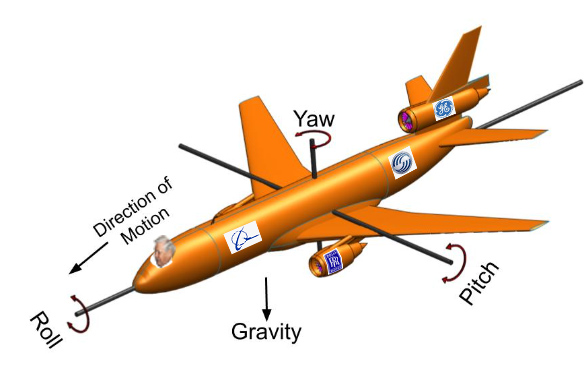
It was the American humourist Mark Twain who didn’t die in 1897 when it was reported that he had. Twain had thirteen more lively years to go.
The death of the Russian aerospace and aviation industry in the present war is proving to be an even greater exaggeration – and the life to come will be much longer. From the Russian point of view, the death which the sanctions have inflicted is that of the US, European and British offensive against the Soviet-era industry which President Boris Yeltsin (lead image, left) and his advisers encouraged from 1991.
Since 2014, when the sanctions war began, the question of what Moscow would do when the supply of original aircraft components was first threatened, then prohibited, has been answered. The answer began at the Federal Aviation Administration (FAA) in 1947 when the first Supplemental Type Certificate (STC) or Parts Manufacturing Approval (PMA) was issued by Washington officials for aircraft parts or components meeting the airworthiness standards but manufactured by sources which were not the original suppliers.
China has been quicker to implement this practice; Chinese state and commercial enterprises have been producing PMA components for Boeing and Airbus aircraft in the Chinese airline fleets for many years. The Russian Transport Ministry has followed suit; in its certification process and airworthiness regulations it has used the abbreviation RMA, Cyrillic for PMA. This process has been accelerating as the sanctions war has escalated.
So has the Russian process of replacing foreign imports entirely.
To understand what has already been done and what the Russians propose to do, here is what Vzglyad (“Viewpoint”), the leading Moscow source for security strategy and tactics, is reporting from Olga Samofalova. The text of her report has been translated and reproduced here without editing; captioned illustrations, videoclips and references have been added. Click to read the original in Russian.
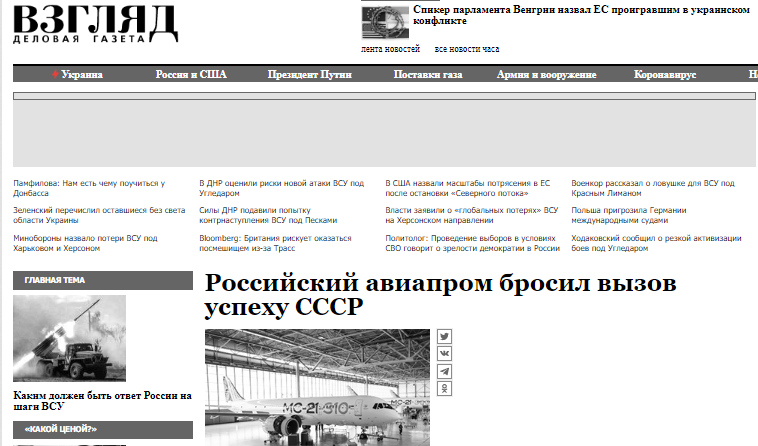
Source: https://vz.ru/
“Russian airlines are massively switching from foreign aircraft to domestic aircraft
September 8, 2022
By Olga Samofalova.
Russia intends to completely rebuild the country’s air transportation. And the first important step on this path is to transfer Russian airlines from foreign planes to exclusively domestic ones. Western sanctions have pushed our carriers to form the largest package of orders for domestic trunkline aircraft in modern history. Is the domestic industry ready for such a challenge?
Russian civil aviation is waiting for ‘systemic rearmament’ and the transition to Russian-made aircraft, Russian President Vladimir Putin said on Wednesday, speaking at the Eastern Economic Forum. According to the President, the country’s airlines have formed the largest package of orders in modern history, for about 500 mainline aircraft of domestic production.
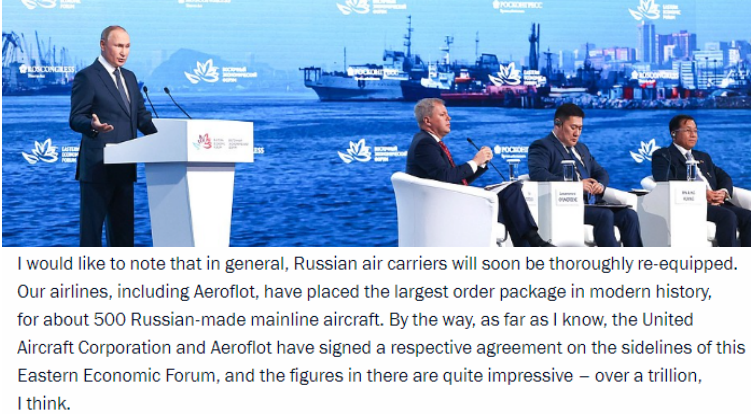
Source: http://en.kremlin.ru/
The interest in domestic aircraft is more than understandable and logical. Firstly, Russia has been creating its own civil aircraft from scratch for two decades, and finally we have not just the SSJ-100 – the first Russian aircraft since the USSR, but also an aircraft in the most popular class in the world – the MC-21 in an import–substitute version with a domestic engine.
The West’s sanctions strike against Russian airlines, which has seriously limited the use of Boeing and Airbus, spurred the acceleration of the transformation of domestic aviation. This is not only about the fact that airlines will now strive to switch to modern domestic technology as quickly as possible, but about the aviation industry which will have to grow to the production volumes that prevailed in the Soviet years – this is something contemporary Russia has forgotten about. Transformation in the industry means the emergence of new jobs – both in airlines and in aircraft factories.
The main order for the 500 domestic aircraft the President announced falls, of course, on Aeroflot. The Group has contracted 323 aircraft. These are 210 Irkut MC-21, 72 Sukhoi Superjet-100 and 40 Tupolvev Tu-214.
THE IRKUT MC-21
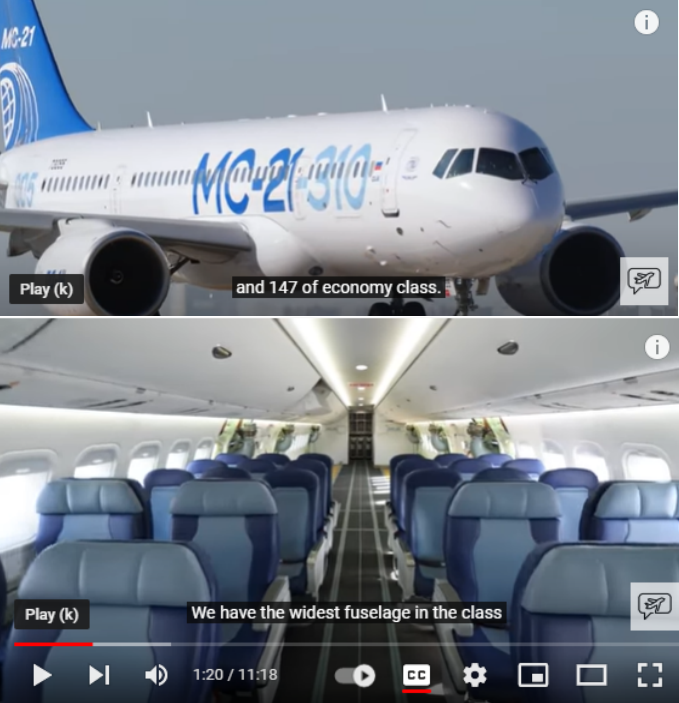
Source: https://www.youtube.com/
MS-21 in Russian, MC-21 in English, stands for Mainline Aircraft of the 21st Century. It was originally developed by the Irkut Corporation and the Yakovlev Design Bureau with the initial designation, YAK-242; first prototype flight was in 2017. Total projected budget for the project to 2025 is estimated at Rb437 billion. The Pratt & Whitney engine was replaced from 2020. The substitution of Russian avionics should be completed by the end of this year. They replace US and European components from Thales, Honeywell and Rockwell Collins. Altogether, it is planned to replace 54 foreign-made units and elements, including the auxiliary power plant, a stabilizer rearrangement mechanism, fuel system, hydraulic hoses, tyres, rescue emergency ladders and rafts, pilot seats, and interior elements of the passenger cabin. Domestic composite materials for the aircraft, include UMT 49S, UMT 42S and UMT 290 carbon fibres based on a domestic PAN-precursor manufactured by UMATEX (part of Rosatom). In addition, it is planned to use a binder tape of the ACM BE-C180UD brand produced by Prepreg-SCM, a company of RUSNANO; and a Robolen 200 tape produced by UNIMTEK. Domestic materials will be used in the design of wing consoles, elevators and rudders, and aircraft mechanisation units. The supplier of the chassis is Gidromash from Nizhny Novgorod. These Russian systems and unit components replace the foreign-equipped pre-war prototype illustrated here:
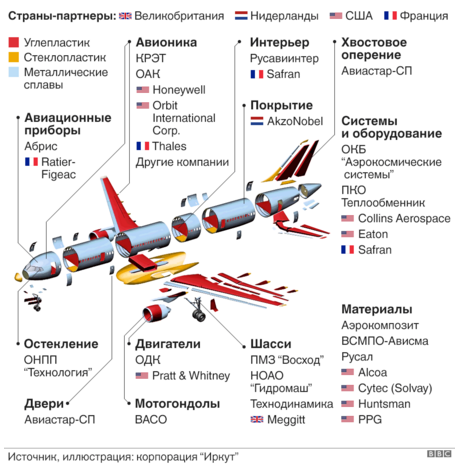
Source: https://aviation21.ru/
To master the operation of the new aircraft, it will be necessary to attract an additional 3,500 pilots. Aeroflot’s development strategy is synchronised with the program for the development of the transport industry until 2030, the head of Aeroflot has noted.
“The Aeroflot fleet now has about the same number of aircraft as it ordered. These are mostly foreign planes. However, every 10 to 15 years, Aeroflot-class airlines completely update their fleet. Therefore, Aeroflot has outlined its needs: over the next decade, to change its foreign fleet to a domestic one. This is if we do not talk about the growth of air traffic volumes, which will require expanding the fleet,” says the head of Avia.ru, https://www.aviaru.net/ Roman Gusarov.
At the same time, civil aviation is quite capable of increasing production volumes not only in order to satisfy the record order of Aeroflot, but also orders from other airlines, Gusarov believes. We are talking about a general order for the creation of 500 domestic airliners; that is, the remaining carriers will have 159 new domestic airliners.
The program for the development of the air transport industry until 2030 worth more than 770 billion rubles, which was approved by the Russian government in the summer, is supposed to deliver as many as 1,036 new domestic aircraft by 2030, but it includes not only the three types of airliners ordered by Aeroflot, but also the Ilyushin series Il-96 and Il-114; the Ural Civil Aviation Plant’s TVRS-44 Ladoga and the L-410 Baikal.
According to the plan, only two SSJ New [Sukhoi Superjet SSJ100, re-engined by United Engine Corporation] will be produced in 2023, but from 2024 the annual production will be 20 aircraft per year until 2030.
The plant has reached such production volumes, so these are quite realistic indicators. As a result, 142 SSJ New regional aircraft will be produced in Russia in eight years (Aeroflot has ordered 72 of the aircraft).
As for the MC-21, the carriers will get their first planes in 2024. It is planned to assemble six of them this year. In 2025 – twice as many – 12 MC-21. And then every year the output grows: in 2026 – 22 MC-21, in 2027 – 36, in 2028 – 50, in 2029 – 72, in 2030 – 72. That is, the plan is to release 70 MC-21 per year. In just eight years, 270 such airliners will be produced according to the plan (Aeroflot has ordered 210 craft).
The Tupolev Tu-214 production plan shows that from 2025 10 such machines will be produced every year, and by 2030 the total production volume will be 70 units (Aeroflot’s order is 40 machines).
THE TUPOLEV TU-214
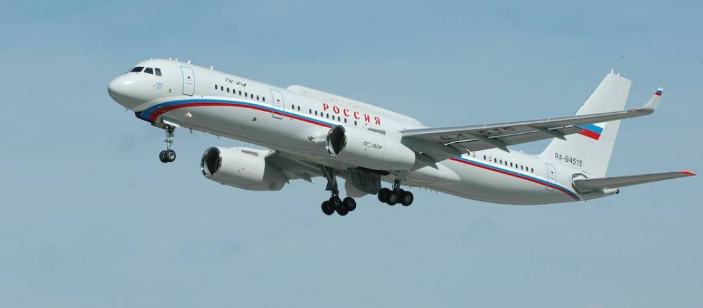
Source: https://www.ainonline.com/
Production volumes exceed the volume of Aeroflot orders. “As you can see, there is still a production reserve for other customers and airlines,” Gusarov points out.
This is a serious challenge for the Russian aviation industry. After all, we are talking about gradually entering the production of 100 civil aircraft per year. And if we take into account the rest of the small aircraft, then by 2029-2030 the total production of civil aircraft in Russia should grow to a record 186 aircraft per year. Russia has never produced so many civil aircraft in modern history. More than a hundred civil aircraft – this is already the level of the Soviet Union.
So, in the 2000s, no more than 20 aircraft were assembled in Russia. In the 2010s, there were some years when volumes grew, for example, in 2013, 35 civil aircraft were assembled; but it was not possible to keep up this level, and production fell again. Another example: in 2020, 11 SSJ-100 aircraft were built, in 2021 – 12 planes. The release rate has been one aircraft per month, but we need to double that.
“Even if not 500, but only 339 aircraft ordered by Aeroflot are produced, this will already be a great success for the domestic aviation industry,” says Gusarov. Understanding that there is a serious portfolio of orders for eight years ahead will allow the industry to see its prospects and invest in expanding production capacities without apprehension. Due to the transfer of the fleet to domestic equipment, Aeroflot is also getting a development strategy for the future so that no sanctions will be able to put pressure on the company,” the industry expert adds.
The MC-21 is a medium–haul narrow-body (single-aisle) aircraft in the most popular and largest-volume class in the world. It is the domestic competitor of Boeing and Airbus. That is why this plane was targeted with individual sanctions. At first, the West banned the supply of composite materials necessary for the production of the unique ‘black wing’. Russia has solved this problem by transferring to its own composite materials. Therefore, the West deprived the project of American engines. But even here the project of creating Russia’s own PD-14 engine has wiped its nose on the sanctions.
THE PD-14 AIRCRAFT ENGINE, REPLACING PRATT & WHITNEY
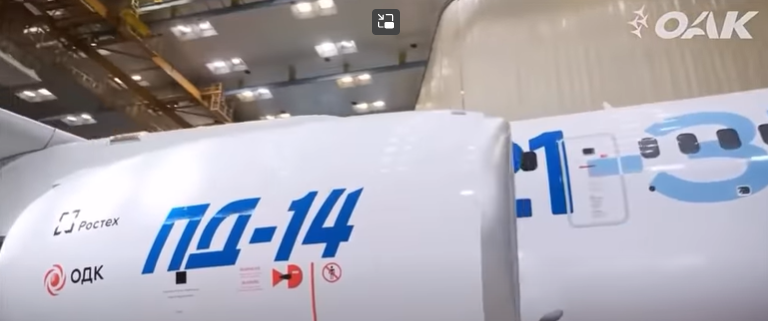
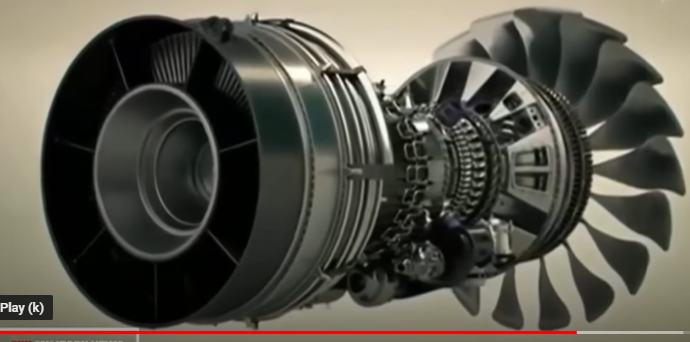
Source: https://www.youtube.com
“There are about 180 seats in the MC-21, this is the most popular variant. You can fly on this plane both in Russia and abroad without restrictions. Except for those countries that simply do not want to see Russian airlines. For the Sukhoi Superjet, it’s exactly the same situation. You can safely fly it anywhere. But this is a different class of aircraft – it is a short–haul aircraft with about half the number of passengers,” says Gusarov.
The SSJ-100 is a regional aircraft for transporting passengers on less distant routes, where passenger traffic is more modest. In general, this is a niche product, and its demand in Russia has been low all these years precisely because long-haul transportation abroad has been developing. However, now Russia is betting on the development of interregional, regional and local aviation within our vast country. And this is also an important part of the ‘systemic re-equipment’ of the aviation industry.
“If we look at the Soviet aviation structure, where Aeroflot was the largest airline in the world, then the Tu-154 was the most numerous aircraft in operation, and it was supported by the half-sized Tu-134. Now it turns out we shall precisely the same configuration. The Superjet-100 is half the size of the MC-21, and they will work perfectly in tandem, complementing each other. On regional routes, planes for 200 passengers are often redundant, they are under-loaded, and it is more profitable to use a half-sized airliner like the SSJ-100, or even turboprop-class aircraft like the Ilyushin Il-114, the serial production of which is also being prepared. But, of course, not on all the routes where the MC-21 flies, will the Sukhoi Superjet be able to fly because it has a shorter range,” says the head of avia.ru.
Aeroflot’s order portfolio includes 40 Tu-214 aircraft. However, this aircraft is in a quite intermediate stage. “This plane also has no restrictions for flights and can fly around the world. But it is unlikely to become mass-produced. This is an aircraft with outdated technologies, and in a number of characteristics it is inferior to Western analogues and the MC-21. But it is needed as a support for the industry for a certain time, while the serial production of the MC-21 will unfold. Our civil aviation needs only about 700 MC-21 mainline aircraft. But by 2030, we will be able to replace only half, at best, two–thirds of the fleet of medium–haul aircraft, and not completely,” says Gusarov. In other words, the Tu-214 is needed to close the gap for a while due to the shortage of MC-21 for all airlines as a replacement for the foreign-sanctioned equipment. However, gradually the carriers will hand over the Tu-214 to the state aviation, to special services, and they themselves will switch to the more economical and modern MC-21.”


That is ambitious to say the least replacing all foreign aircraft with domestic ones. And if the aircraft prove themselves reliable, that would mean that there would be a lucrative export market for aircraft deliveries countries around the world. Of course that brings up the subject of all those Boeing and Airbus aircraft stuck in Russia which the Russians are using for free. I suppose that it unlikely that they will ever be returned to the west as that would require good faith negotiations. And that means that the Russians will probably have to send them to an aircraft boneyard sooner or later-
https://en.wikipedia.org/wiki/Aircraft_boneyard
But of course those sent to the boneyard will provide spare parts to the remaining Boeing and Airbus still flying until they can be replaced with domestic versions. The Russians are getting a lot of practice with replacing imports. As an example – they had a problem with marine engines in 2014 for their Navy as they were manufactured in the Ukraine so they threw the resources at the problem to make them for themselves.
As I’ve commented before: Russia has a smart and determined culture, today. The times they are a’changing.
No word on long-haul? Airbus 320/Boeing 747?
There was a project of Russian / Chinese collaboration, but as is often the case, China seems to be pursuing its own course.
It’s not radically different to making a long haul aircraft.
The fuel fraction of longer haul aircraft has to be higher. The A320 is not truly a long haul aircraft by the way – it’s more of a Boeing 737 competitor, unless you are referring to the A321XLR and even that isn’t the longest haul aircraft. More of a “longer” range version of a single aisle aircraft that could do flights over the Atlantic.
Truth be told, 4 engine aircraft like the Boeing 747 are being phased out in favor of aircraft like the Boeing 777 and Airbus A350 – they just use to much fuel and cost to much to maintain, especially with ETOPS.
The bigger challenges are making engines competitive with Airbus / Boeing counterparts, modernizing Russia’s avionics industry, and other specific components in the supply chain.
Actually, there’s a bigger issue not discussed. Companies like Boeing are prioritizing short term profit and share buybacks, as hinted by the 737 MAX incidents. A nation like Russia or China that prioritizes making great planes might win in the long run. Improving airline safety is another big challenge for Russia as well, but again, this can be done with time, money, and a strong safety culture.
That could take decades however, but with the business culture in the US, it may be inevitable.
That depends on how the nations shifts in priority once Putin and Xi are out of the way once and for all.
What is that saying again, 3 generations from riches to ruin?
For long haul it’ll probably be Il-96-900M. Old bird, but this total modernization of Il-96-900T cargo version. Test flights planned for this or next year and mass production decision will be made after those. Ilyushin is also looking into a two -engine model if and when PD-35s engines come available (planned in 2025).
The Russian Chinese collaboration is currently known as CRAIC CR929. It’s still going forward, but it seems Russia is not happy with the development. It’s unclear whether China wants to use too many western parts for Russia’s liking, or Russia sees it merely as a technology transfer to China rather than producing an aircraft for Russian needs.
Curious, i find various mention of -300 and -400 variants. But nothing about -900. I do however find indication that Boeing got involved in smothering some trade agreement that would have provided US engines.
The aircraft industry is really nasty…
Look into past Boeing collaborations with other aircraft manufacturers to access their IP and then backing out. Very USian. Bombardier and Embraer are recent examples.
Why i can’t but help laugh when USA accuse China of industrial espionage etc. Turnabout is fair game, as they say.
You are correct, it was way after my bedtime, so I mistyped. It’s IL-96-400M I was referring to.
The Russians are deeply suspicious of China when it comes to aerospace. The Chinese have a long history of ripping off Russian tech and reverse engineering whatever they buy (and not returning the compliment). In the past they were inferior knock-offs, but increasingly they are even better than the Russian equivalent, such as the J-16, which is arguably far superior than the Sukhoi 27/35 series it was derived from. The Chinese engine industry is almost entirely based on reverse engineered Russian tech. I don’t think anyone in the Russian aerospace industry is under any illusions about what will happen if they ‘collaborate’ closely with China.
It has to be said that Russia doesn’t have a great history with cross-national collaborations – their relations with the Indian aerospace industry haven’t been particularly fruitful for them either. As the Europeans have proven over decades, cross national collaborations in aerospace sound great on paper, but often prove very difficult and expensive in reality. Arguably, the only reason Airbus has been such a success is that the French kept very close control over all aspects and stopped ‘partners’ interfering too much in crucial decisions.
Sorry, I do know a thing or two about commercial aviation and the idea that Russia or even China will be able to produce commercial aircraft anywhere near as efficiently as Boeing and Airbus in the next 20 years is nonsense. Developing a viable domestic aircraft manufacturing business has been a huge priority for both countries for decades but they’ve gotten nowhere. The last major Russian program (SSJ-100) was a complete disaster. Even countries that were basically given the aircraft for next to nothing (Mexico) quickly decided to ground the fleet. Even Aeroflot wanted nothing to do with them, and the few aircraft it acquired were transferred to smaller provincial carriers. Remember that “aircraft” technology is really “engine” technology (aluminum tubes aren’t all that challenging) and post-USSR programs all relied on Western engines and avionics.
China is far better than Russia at copying Western technologies and at sophisticated manufacturing processes (and has the largest domestic demand for aircraft outside the US) but its recent efforts (the Comac ARJ21 and C919) are totally uncompetitive. The major carriers (Air China, China Southern, China Eastern, Hainan) have no interest and they are only flown (in very small numbers) by secondary airlines.
Remember also that every other European country that tried to maintain a commercial aircraft industry shut down those industries decades ago.
I agree with you in general, but the key phrase in your comment is “anywhere near as efficiently”. Efficiency has nothing to do with it, not anymore. If Airbus and Boeing will no longer service jets in RU, then RU has no choice but to make its own jets. And they can certainly do it, they already are (on a small scale post-USSR), and the resulting jets will be inferior to those produced by Airbus and Boeing. But they’ll fly. I’ve flown countless times on clunky old Ilyushins and Tupolevs and Yakovlevs, my personal favorite being the Tu-134 with a skylight window above the toilet (why they put one there, who knows). Noisy and inefficient and uncomfortable airplanes, but they flew.
Your comment is spot on.
I think commenters are are still stuck thinking about the industry in 2019 terms. The question isn’t whether Russian civilian aerospace is competitive with Boeing and Airbus, they aren’t, and I don’t necessarily think that they will be by 2030 either. The question is, can Russia build enough domestic passenger jets to replace Airbus and Boeing in their domestic market? If they can build planes that get them 80% of the way there, they can keep flying, otherwise the Russian airline industry is looking at an Iran-type scenario where they have to keep flying their Western aircraft and scrounging for parts to keep them in the air.
Sanctions won’t be ending anytime soon, so they really don’t have a choice.
To clarify, my “anywhere near as efficiently” comment could be rephrased as “achieving a level of efficiency where Russian and Western commercial jets might be mentioned in the same sentence without eliciting laughter”.
The first major flaw in the Helmer piece was the failure to clarify the current economic warfare context. Yes, Russia could probably produce aircraft that meet basic safety standards to replace Boeings and Airbuses, but this is analogous to saying that Germany could reopen enough coal plants to cover the loss of Russian fossil fuels. But the slow speed and staggering cost of this import substitution destroys the economics of the industries that depend on them.
The second major flaw is that the economics of aircraft manufacturing mean there is no way Russia would rebuild large scale production. It is exponentially more than just reopening an aircraft factory. You need an elaborate infrastructure of engineering, maintenance, sales and industrial subcontractor support. Russia always had a reasonable engineering base, as did Britain, France, Japan and other countries that invested billions in the hope of building a domestic aircraft industry. These are the problems that killed all recent Russian aircraft programs (and have sharply limited the Chinese). Imagine what it would take for America to restart all of its 1990s domestic semiconductor production and multiply by 10.
All of this requires massive economies of scale and captive markets that will accept hundreds of aircraft while programs slowly mature, and massive Airbus-type state subsidies to keep the train moving in the decades before maturity. The future market for Russian aircraft is a fraction of the market USSR era producers could depend on. Even before the current economic war, Russia had none of that, and the idea that they could quickly make major strides towards rebuilding a commercial aircraft industry that could mass produce aircraft vaguely sort-of comepetitive with the Western aircraft of 30 years ago is ludicrous.
But what happens when you add Russia, China and Iran together? Remembering that there is a lot of crossover between military and civil aviation manufacturing capability…
Certainly you’re right in that the economics never made sense for post-Soviet Russian aircraft, and that’s borne out by the production numbers per year for planes like the TU-204/214 and IL-96, which were the last cutting edge Soviet era designs to make it into service (early 1990s). The production rate can be checked on Wikipedia (I’d link it but it makes my comments disappear), but it’s an absolutely abysmal 1 or 2 a year for the most part, because of the chaos of the 1990s and a lack of interest from buyers, even Russian ones.
For the Sukhoi Superjet, the first post-Soviet Russian airliner to be designed and built, it seems that their best year production-wise was 36 aircraft back in 2014 (according to Wiki), and in an article on the website RUaviation from back in March of this year (titled “Superjet on sanctions” by Roman Gusarov), the maximum envisioned production capacity was 46 aircraft per year, albeit that I believe was based on having access to the originally designed Western parts and supply chains. Note also that 2014 was the last year they had access to most of the Western aerospace production chains. I think this gives us a baseline as to what the modern Russian aircraft industry is theoretically capable of producing.
As far as I can tell, based on their military production capabilities, Russian industry can make nearly every part that aircraft need; radars, landing gear, wings, modern glass cockpits, engines, etc. Is that translatable to civvie jets and parts in the quantities necessary? I have no idea. It’s probably unlikely but I don’t see what other choices they have if the sanctions continue, because Russia won’t be buying any more Western planes for a long time to come.
I think it is, in the sense that “critical parts” of Russian industry have been reorganized under large government controlled corporations.
As far as I can tell, the latest wonder of Russian aviation industry, MC-21 is a collaboration of over 120 Russian companies. And it seems the planned production capacity was around 50 airplanes a year, pretty close to SSJ max production.
There are news about Tupolev starting construction of 20 new Tu-214 fuselages. The whole production run is expected to be 70.
This year alone Aeroflot has ordered 389 new Russian airliners, Red Wings 60 and Rossiya 33, so somebody somewhere must be planning serial production by now. Those 500 passenger aircraft ain’t gonna built themselves.
Indeed, it’s not something I would dismiss completely because Russia does have a few bright spots in their aerospace sector. Russian helicopters are very competitive internationally and are one of their better export earners (at least before this war); they were even good enough for Uncle Sam to want to buy a bunch for the Afghans a few years back – at least until the deal was scuppered due to the wailing of the US MIC.
So the companies do exist domestically that can make the parts aircraft need. How well that works for the kinds of volumes Russia is talking about here, I guess we will see!
Keep in mind that Airbus will likely see an increase in production costs if the sanctions keep going – Europe is going to be facing higher energy costs. That also means higher costs for aluminum, and any other components that require a lot of energy to manufacture.
Airbus would have to move more production out of the EU, where energy prices are cheaper. That is not politically acceptable for the EU nations because Airbus was originally made as a sort of jobs program that is heavily subsidized for the EU. Originally there was a belief that Airbus would “win” the airplane wars due to Boeing’s missteps that resulted in the 737 MAX, but now that’s in question.
The other issue is that self sufficiency is far more important than any “efficiency” considerations (which were a justification for the neo-liberal “free trade” in the form of “comparative advantage”). Being able to make one’s own aircraft is far more important because of the possibility of sanctions.
In the long run, it’s a matter of capital investment and R&D money. China will continue to throw money at the problem. Eventually it’s going to reach a point where they begin to catch up and surpass the US and EU. There’s nothing that is indomitable about the EU and US aircraft industries. It’s a matter of decades of accumulated knowledge and experience, along with previously spent capital investments.
Will there be mistakes that China and Russia make? Sure. But if they commit enough resources to building an aerospace industry, they can certainly compete and perhaps even surpass the EU or US.
Russia is putting a lot of effort on the new Aviadvigatel PD-14 engine, and it’s derivatives. I believe they are planning to produce 200 engines per year, when they get the production lines in Perm running (but I may be wrong, it’s really hard to find data).
The Mexican Interjet did deny the report it had issues with SSJ. They could lease 10 for the price of one pre-delivery payment of Airbus 320. After covid killed air-traffic, Interjet did return their leased SuperJets. And filed for bankruptcy.
I don’t think nobody can compete with Airbus or Boeing, even if they had better and cheaper airliner. Those two just absolutely control the market, the support, the training, the everything. And they (allegedly) have the best kickbacks in the business, too.
Hubert.
I did work in the industry, I’m sorry but I find this rather common belief (they will never be able to compete) unconvincing and, frankly, a bit lazy.
The aviation industry is one of the least efficient (huge political pressure, bribes/kickbacks, etc..) the current crop of western design is not exactly ground-breaking with Boeing, for example, continuously recycling a 50+ years old design with catastrophic results in its latest iteration. Even when it comes to powerplants, there is nothing particularly “exciting” (pass me the term).
Russia is far ahead of China when it comes to the aviation industry, both military and civilian (just to mention the fact that the Soviets/Russians had and still have an actual civil aviation industry, China practically does not).
The real problem for the Russians is not their technical capabilities or lack of thereof but their poor “customer focus” mindset which was the main reason of the SSJ-100 debacle when inevitable issues, typical with any new design, were not addressed promptly with also serious logistic problems.
The MC-21 is very promising and so the new iteration of PD engines.
Finally, even if the Russians could come up with airliners better than the western counterparts on most aspects and even cheaper, do you think any Western and even some of the Asian potential customers would ever consider buying one?? Of course not, again this Industry is not one when the “best” product necessarily win.
However we are entering a new era where even western plane manufacturers will lose some of their efficiencies (supply chain fragmentation, championing national products agendas, etc..). In this “brave new world” national security and technological independence considerations for some nations will play an increasing role against real of perceived better efficiencies. The past failed attempts by China and Russia (we need to ask ourselves were they really trying or were they just half backed efforts in an ocean or readily available western airplanes with no clouds on the horizon?) may not provide a useful guide for the future in this new reality.
Finally, my Russian airliner passenger experience was with the Il-96 and, frankly, again as passenger, it was perfectly comparable with western designs of similar vintage.
I agree very much with this. Modern aerospace is now a very mature industry and despite decades of investment, the Russians and Chinese (and the Japanese, Brazilians and Canadians) have never been able to knock the Europeans/US off their dominance. In many ways, it was almost miraculous that Airbus managed to stop the US having complete control, all the odds were stacked against them.
The Chinese have invested something of the order of $80 billion in Comac, and they are still mediocre aircraft with even third world discount operators turning their noses up at them. Russian attempts have been plagued by rushed designs which have proven lethal in the case of the Sukhoi.
Whats often forgotten is that ‘new’ entrants to the industry are not competing with the latest Boeings and Airbus designs. They are competing with a market awash with very good second hand aircraft, often just a few years old but available at a far lower price than even the cheapest Comacs can match. Persuading small discount airlines around the world to invest in a new aircraft when they can pick up A320’s and 737’s for very little in the open market is a very hard sell, and the vast majority just aren’t interested. And the big operators are very tightly linked in with either Boeing or Airbus’s infrastructure – they would be very reluctant to change this, no matter how low the prices go. Even the likes of Ryanair have never deviated from Boeing – its just too expensive and difficult for them once they’ve made that long term committment.
The market for larger, long haul aircraft is particularly difficult – even the big two struggle sometimes to make them pay. They represent a huge investment for even the biggest airlines, so they are inclined to be even more conservative in their choices. A Russian/Chinese alternative would have to be exceptionally good and exceptionally cheap to break in to that market. And neither have proven able to achieve this.
Worth noting that the one part even those pencil-necked MBAs in Chicago never outsourced was the wing. Until the 787. One wonders what Boeing’s distinctive competence really is. Not, it would seem, manufacturing.
The thing about Boeings incompetence is that despite this, they still sell lots of aircraft. Momentum means a lot in an industry like aerospace. I’ve not met anyone in the airline industry who worries about Boeing long term, as there seems a general assumption that its TBTF, so no matter what they do, the US government would step in to protect the domestic industry.
I presume that the worst case scenario for airlines is that a failed Boeing would be force married off to Lockheed or similar, or sold off to an Elon Musk type. It would never be allowed die and leave purchasers high and dry. I also suspect that its in Airbus’ interest not to stick the knife in when Boeing is at its weakest – the duopoly suits Airbus, they don’t want to be in everyone’s sights as a de facto monopolist.
The problem for any newcomer to the duopoly is that many airlines will play footsie with them (Ryanair do this all the time) in order to keep Boeing/Airbus on their toes and drive a harder bargain – but when it comes to handing out cash, they go for the safe option in the end. This I think is why the Mitsubishi Spacejet failed – it was a fantastic design, but ultimately didn’t offer enough to make any airline want to change from established suppliers.
The issue will be the efficiency and durability of the domestic engines.
I don’t know if the Russians have the technology for a geared turbofan, though their decades of producing the most powerful engine gear boxes in the world implies that they do, but they also have significant experience with 3-spool engines as well.
And high speed rail? Russia is a vast country, but so is China, and the Chinese built the biggest HSR network in the world in a couple of decades. It would be nice to see cooperation on that front, too (mumbles something about climate change).
When I was going to gradschool, jokes were made about Chinese compared to Japanese or French hi-speed rail. Not any more.. and that’s under 20 years to catch up to and surpass an industry that once was considered an untouchable comparative advantage.
The Chinese HSR is indeed impressive in its scale. But not in technology. Indonesia remains the only country that has bought significant quantities of Chinese rolling stock and that’s probably only because it was a condition of the loans. Most Chinese HSR’s are essentially reverse engineered older Japanese designs, and others are licensed European designs. China lags well behind Japan, ROK, Spain, Sweden, Germany and France when it comes to selling train tech or just off-the-peg rolling stock.
According to TrendEconomy site (no idea of the trustworthiness), in 2020 (latest year available) China exported “railway or tramway locomotives, rolling-stock and parts thereof” worth of $9.78 billion, whereas Japan exported worth of $646 million.
That would be 15 times more, assuming equal price.
A lot depends on how you categorize railway parts – most of the figures I’ve seen indicate that China is a lot smaller in world terms – about 10% of the world total for locomotive exports, which pretty minor when you consider the sheer scale of the Chinese industry. Its barely larger than Austria (7%).
Those figures in your link are, I would guess, overwhelmingly lower level parts – mostly licensed from European companies that do a lot of their subcontract sourcing in China. And a lot of it is possibly steel track, almost all of which comes from China. Many heavily engineered parts for European or other Asian companies, such as the chassis, are sourced from China and basic locomotives (for goods trains) are also made in China. But HSR – nope – just check out the sourcing for any existing or proposed HSR line in the world. The Chinese barely feature – even the Koreans, who don’t really have a proper network are bigger players.
Much of the reason for this isn’t necessarily cost or quality – its simply because most Chinese HSR use licensed or reverse engineered tech, and so it can easily be blocked legally by competitors outside China.
I’m not saying this just to have a go at Chinese industry. Its simply a fact (because at the time I worked in the industry) that back in the 1990’s everyone assumed that China would be able to outcompete everyone in HSR and subway railway design and sub-contracting within a decade or two. But it never happened at anything close to the scale that was assumed. I’ve no idea the reason for this, but I suspect that the emphasis on reverse engineering within the industry created a culture that led to them falling behind in tech and manufacturing – especially to the Koreans, who came from almost nowhere to become major players a few years back. The level of corruption in Chinese railways is probably also a factor.
China is pushing ahead with some new tech, especially in maglev. But they are substantially behind other countries and I’ve not seen anything to convince me that they are going to overtake the established players. If anything, I think the Koreans are going to grab any available market (off the Japanese too).
What’s the flip side of this? We know that Russia is keeping all the leases Boeing and Airbus frames and so can likely bridge the gap to internal production. Is the loss of the Russian market significant to either manufacturer? And Russia is at least in position to develop and manufacture almost everything domestically from domestic raw materials.
I take other commenters points about previous failures of the Russian industry, but does that change when there isn’t the east option of just leasing Boeing or airbus units? Now there’s a state supported, mandate for the industry and does it act like a flywheel? Internationally, how stable is Boeing as a company; can it take any financial shock that might happen? How does airbus deal with high energy prices and difficulty getting components?
Russian airlines have nearly always used domestic aircraft when available. The problem is that its market is really too small for a self sustaining industry. It has to be a player on the international market for the capital investment in new aircraft and engines to make sense – similarly for China. And if it is using what would amount to pirated western technology, then any sales could probably be blocked on legal grounds.
Russian airlines have nearly always used domestic aircraft when available.
This isn’t correct, and hasn’t been since at least the 2000s, when Russian airlines largely replaced their Soviet-era planes with Western aircraft. If you look at a list of the top airlines in Russia and their fleets, you’ll see that they got rid of pretty much all their Russian planes by 2010, 2015 at the latest. They were unwilling to buy Russian built aircraft even when they were available because they weren’t competitive with Western aircraft in terms of fuel use and operating costs.
These newer designed Russian passenger jets likely won’t be competitive with Boeing and Airbus either, but the thing you’re missing is that they don’t have to be, because with the sanctions in place Russian airlines won’t be able to buy or operate Western aircraft. They can’t even pay for them if they wanted to! So it’s either fly something Made in Russia, or don’t fly at all.
I said ‘when available’. For a long period the industry was incapable of supplying appropriate aircraft.
Point taken, ‘available’ is definitely a bit iffy to deduce for the Russian birds early on. The Il-96 was supposedly introduced and ‘available’ from 1992; the Tu-204 introduced and ‘available’ in 1996. So theoretically, Russian manufacturers were offering those two aircraft from the 1990s and by and large, Russian airlines shunned them for western aircraft instead. Of course, how available they actually were I have no idea, but I suspect, given the state of the Russian economy in those years, ‘available’ was probably more theoretical than actual.
Something tells me it might be more like Boeing, and perhaps Airbus after reading comments above, will be sinking to the Russian/Chinese level of competence *because neoliberalism*, then falling below that level, more so than Russia upping their game to catch the current leaders, although they might actually do that as well.
Planes are not much good without pilots, 3500 new pilots required to service all those new jets. That seems to me a huge ask, you cannot make excellent pilots without simulators, Does Russia have the capacity to ramp up simulator production?
I remember flying on a Malev Tupolev in the 1990s. It was scary.
I remember flying to Moscow on an Ilyushin in the 1990, not any scarier than flying always is (for me). Flying back on Aeroflot Boeing was scarier, the pilot flew like it was a fighter, not an airliner.
No offense to all the Russian savvy, and I admire them and their pluck, but the Chinese have COMAC and have their eyes on the Boeing and Airbus duopoly and if I were a betting man, I’d be thinking they have the inside track. But since Boeing is our national champion and Airbus the Europeans’, forgive me for suspecting both bureaucracies will bury the interlopers in red tape. Anybody thinking an STC for a Russian engine will see one on the wing of American Airlines Boeing just because it copies a Pratt is smoking something. Me? Not holding my breath and not afraid of the Russians. The Chinese? They have a vast population to serve and I definitely see COMAC doing it. Moreover, they’ll depress prices for used Boeing in Africa and 3rd world nations. Also in cargo. As to who domestically takes the plunge? Dunno. The airline business is on the ropes right now no matter what absent a sterilizing vaccine. And politics the way they are, seeing East Asian aircraft in our skies is a no time soon scenario, I suspect but it’s an interesting question.